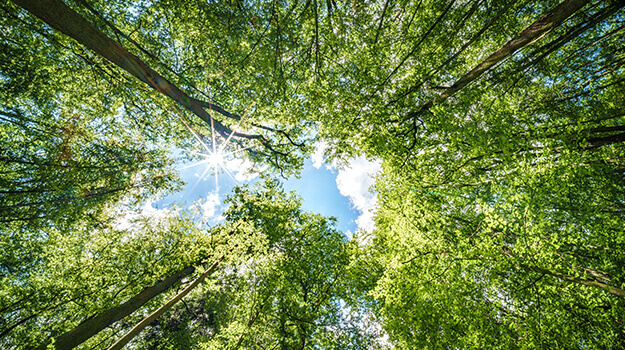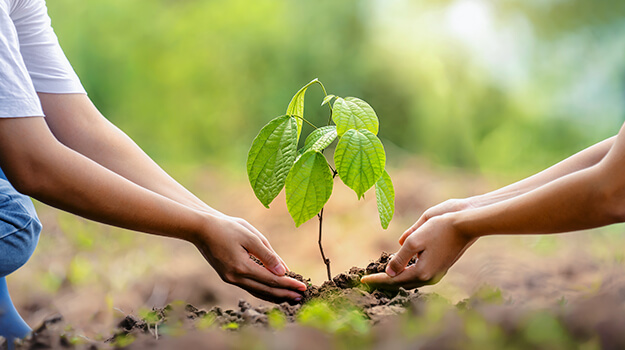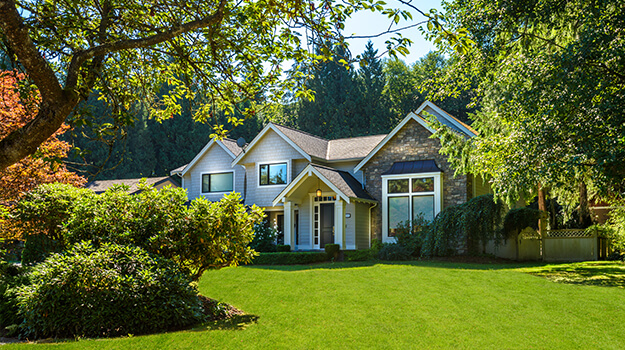The trees that compliment our lawns and gardens are well worth the once-a-year raking ritual they demand. Trees are a valuable accessory to our lawns and landscaping, and, like lawns, they are natural sound barriers and air filters. Planting trees makes the most of nature's ability to combat climate change.
Temperature and trees
It's an instinct to take refuge under a shady tree on a hot day. Trees planted around buildings will cool them in the summer. One large tree can cool the same amount of air as 15 room-size (4,000-BTU) air conditioners.
When trees are planted around air-conditioned buildings, they reduce the load on the air conditioning system by cooling the air before it enters the conditioning system. This can reduce energy costs by 18 to 50%.
Evergreen trees planted around buildings also act as a windbreak and can reduce winter heating costs by 4 to 22% by reducing the speed of winter winds moving around buildings. Using less heating fuel in winter also lessens the atmospheric levels of carbon dioxide and other greenhouse gases given off when heating fuels are consumed.
Trees and air pollution
It is estimated that one mature tree can generate enough oxygen for a family of four, and that an acre of trees supply enough oxygen to meet the needs of 18 people.
Trees are also important air purifiers. During the process of photosynthesis, plants absorb carbon dioxide, using the carbon and releasing the oxygen. One mature tree will absorb almost 12 kg of carbon dioxide annually. That is roughly equal to the pollution created by driving one car 17,600 km.
Researchers have recently confirmed that the carbon found in the tissue of a tree comes entirely from the air. The age and vigour of the tree are important factors in its ability to purify the air. A mature and healthy 50-year-old sugar maple will annually convert 120 times more carbon dioxide than a tree that is 10 years old. It is critical to properly care for trees so that they reach full maturity.
Community involvement to fight climate change
In some cities, inner-city tree planting programs are paying community dividends. Supported by groups of local citizens, residents have been planting trees in their neighbourhoods. Not only did the tree planting beautify the community, but it also brought people together and helped generate a sense of community and shared ownership.
Being kind to trees
Older areas in cities are often graced with stately mature trees that form a beautiful canopy over the streets. In modern subdivisions, many trees die early, often within 15 or 20 years, and often the conditions of the root bed are to blame.
During construction, the subsoil has been heavily compacted by earthmovers and backhoes, and by the time the building is completed, the soil is like concrete with a few inches of surface topsoil. Often, especially in boulevards, the tree roots are forced to grow under asphalt and concrete.
Trees planted into this soil will not thrive without special care. If you are planting a new tree, follow the planting instructions carefully. Amend the soil with compost and MYKE, a natural biostimulant, and water the tree well and frequently until it is established.
When you plant, leave a raised ring of soil around the planting hole to better capture your watering efforts. Water is critically important to all trees, established and newly planted, especially in a new subdivision where the soil's water retention capacity is very low. Applying a layer of mulch on top of the root ball helps keep in the moisture.
Fertilizing
One method of fertilizing a young tree is to simply apply it in heavier applications under the tree than on the rest of your lawn, remembering that the grass under the tree will capture most of the nutrients.
Water-soluble and liquid fertilizers must be combined with water before application, and this method ensures that some water gets to the tree as well. Always follow the instructions on the label to avoid underfeeding or wasting the fertilizer, and if in doubt, ask for advice at a nursery or garden centre.
Keep in mind that the feeding roots of an established tree are where the outer limits of its branches are. This is called the drip line, that is, where rainwater drips when the leaves are in full growth.
You can fertilize your growing tree by poking 10 to 15-cm-deep holes around the drip line and with the aid of a funnel, pour lawn fertilizer into each hole.
Watering and fertilizing a tree is also the best way to prevent insect and disease infestations. A strong tree can resist these stresses better. If insects become a problem, take a specimen to a nursery or garden centre and ask for advice.
Pruning will remove potential sites for disease and allow strong limbs to develop that will withstand wind and storm damage. It will allow you to shape the tree as you wish and reduce potential drought stress caused by unnecessary foliage.
Give them some air
To ensure that your trees have the air they need at the root zone, keep parked cars, footpaths, patios, storage sheds and driveways away from trees. These tend to compact the soil and reduce the availability of air to the roots.
When properly maintained, trees will provide years of beauty and clean air, and help cool our homes in summer and protect them in winter. A little kindness (and a little raking) will be much appreciated.





